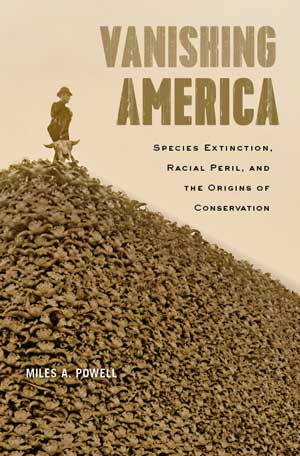
Vanishing America examines how, between the mid-nineteenth and mid-twentieth centuries, American conservationists came to connect wilderness preservation to the maintenance of a rugged white race. In surprising ways, numerous leading environmental reformers drew parallels between nature conservation and race preservation in the form of race science, eugenics, immigration restriction, and population control. For some of these figures, such as prominent eugenicist and wilderness advocate Madison Grant, these fields blurred together in a united campaign to save “the old America.”
This rising association between white America and the nation’s wilds represented a major transition in U.S. environmental and racial thinking. Earlier generations had typically connected wilderness with Native Americans, and had expected both to vanish in the wake of national development. Yet, by the early twentieth century, wild lands were firmly linked to national and racial vigor in the country’s mythic imagination. With wilderness reimagined as a font of white American strength, environmental reform became a far more powerful political force at state and federal levels.
As increasing numbers of white Americans ventured into wild lands in National Parks and Forests to offset the supposedly degenerative effects of urbanization and industrialization, some criticized the enduring presence of Native American peoples there. Groups such as the Blackfeet (Pikuni) Indians in Glacier National Park found themselves barred from subsistence activities they had engaged in for centuries and even millennia. They were, however, permitted to serve as entertainers and guides to enhance the dominant culture’s experience of these rugged places.
These developments helped ensure that U.S. environmental protection, especially outdoor nature preservation, became an overwhelmingly white movement. With many conservationists explicitly connecting their cause to race-based eugenics and immigration restriction, it was easy for the nation’s people of color to feel alienated from the campaign. Attendance figures at parks and membership rates for environmental organizations suggest that this estrangement has endured to some extent through the present. This poses challenges to environmentalists as they seek to broaden support for their movement.
When I commenced research for this book, I planned to focus predominantly on understandings of, and responses to, species endangerment and extinction. Yet archival materials and other primary sources revealed that in historical times many influential conservationists were equally concerned with the perceived racial tolls of environmental change. Beginning by writing eulogies for the supposedly doomed Native American race, and then increasingly fretting over the future of white America, environmental reformers like Madison Grant, William Temple Hornaday, Aldo Leopold, Henry Fairfield Osborn, and Theodore Roosevelt asserted that the same forces that endangered the nation’s wildlife also imperiled particular racial groups. By analyzing these writings, Vanishing America draws together two fields—environmental history and the history of race and ethnicity—that typically receive separate treatment, providing fresh insights into both.
Within these discussions of endangerment, understandings of race and nature converged in multiple ways. Pundits readily applied scientific principles derived from the study of nature to human groups, and the inverse also occurred. In the mid-nineteenth century, influential racial theorists like Josiah C. Nott divided the country’s non-European wildlife and peoples into two categories. On the one side stood buffalo, African-Americans, and other organisms that would supposedly accept domestication to endure in the presence of European creatures. On the other stood wolves, Native Americans, and other beings that defied domestication and would therefore have to be destroyed to facilitate Euro-American progress in the form of expanding agriculture, industry, and commerce.
Around the turn of the century, the intellectual parallels drawn between the imperilment of species and races took new forms. Leading conservationists such as Grant, Hornaday, and Osborn warned that just as alien species threatened native organisms, so too did non-WASP immigrants pose an existential threat to white America. In both instances, the commentators considered the “native” creatures to be superior, yet somehow less competitive within the strictures of an artificial and degenerative industrial and commercial order. Grant and Osborn also drew on game management strategies devised to preserve wildlife, such as the culling of inferior males from breeding stocks, to promote race-based eugenics in the United States.
Perhaps the greatest challenge I faced in writing this book was presenting a balanced depiction of the celebrated conservationist and nature writer Aldo Leopold. Few people have thought more deeply about the human relationship to nature, and he presented his ideas in beautiful, flowing prose. He played a key role in an early-twentieth-century wilderness movement that set aside vast swaths of federal land in a somewhat pristine state (at least if we disregard historical ecological transformations propelled by Native Americans). For species requiring large ranges, like the grizzly bear, this may have played a key role in their preservation.
Yet Leopold’s love for wilderness had a troubling upshot. His pursuit of unpeopled spaces engendered a disdain for human population growth that sometimes involved callous disregard for the worth of a life. Fearful of producing “more strain on an overcrowded range,” he questioned the wisdom of providing medical aid or agricultural assistance to vulnerable people in the developing world. Leopold exchanged these ideas with the ecologist William Vogt, who made similar arguments in his bestselling book, Road to Survival. Lacking Leopold’s subtlety and using more overtly misanthropic language, Vogt encountered criticism for rekindling fears of “yellow peril”—the prospect of the nonwhite races of the world (especially Asians) swamping white nations through greater reproduction.
Interestingly, Leopold’s opposition to human crowding appears to have informed and been informed by his investigations of animal populations. Leopold’s most famous game management study centered on the deer of the Kaibab Forest in Arizona. He believed that their population had irrupted due to state-sponsored predator extermination before the deer overgrazed the landscape, propelling their own annihilation. Leopold and Vogt likened the extermination of wolves and cougars in the Kaibab to the eradication of disease and hunger among people of the developing world. In both instances, human interference threw the balance of nature off kilter, setting the stage for future environmental exhaustion. Such assertions failed to recognize that, in many instances, increasing affluence and security actually brought about a leveling of human population growth.
By drawing associations between white American vigor and the nation’s wild lands, these conservationists set the stage for an enduring divide between the U.S. environmental movement and the country’s poor and nonwhite people. This is unfortunate because most environmental activists today almost certainly do not share the racial views of their predecessors. Indeed, many environmental organizations are now seeking ways to diversify their membership and broaden their support base.
These historical legacies are difficult to overcome, though. When the Sierra Club toyed with adding immigration restriction to its agenda in the late 1990s and early 2000s, it faced accusations of racism and xenophobia. Most of the advocates of this policy were likely acting on a perceived correlation between human population growth and increased environmental impact. According to this perspective, the backlash they encountered would have seemed perplexing and surprising. When these proposals were placed in the context of the history described above, though, the reaction made perfect sense.
With Vanishing America, I do not seek to devalue the immense accomplishments of the historical actors under scrutiny. These conservationists foresaw the danger facing many of the nation’s birds, fish, game, and plants, and articulated sophisticated arguments for their preservation. They helped achieve important and necessary reforms that likely prevented the extinction of the American bison, California condor, and other iconic species. I do, however, hope that by revealing American conservation’s often exclusionary and racist past, this book will help set the stage for a more inclusive and effective environmental dialogue moving forward. It’s time for a new environmental movement, one involving a wider range of voices, and devoted to preserving a broader vision of nature.


Miles Powell received his BA and MA from Simon Fraser University, where he researched the environmental history of Native herring fisheries in British Columbia. He completed doctoral studies at the University of California-Davis, developing fields in environmental history, American history, and world history. His first book, Vanishing America: Species Extinction, Racial Peril, and The Origins of Conservation, uses discourses of extinction to explore connections between racial attitudes and environmental thought in late-nineteenth and early-twentieth-century America. He is presently an assistant professor of environmental history at NTU in Singapore, where he researches the global history of human interactions with sharks in the twentieth century.